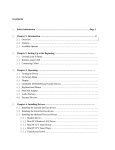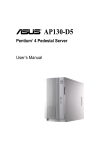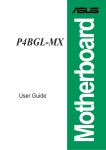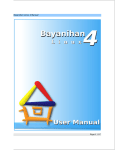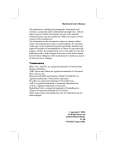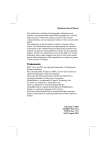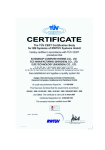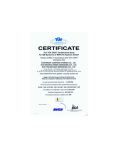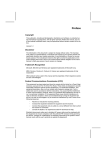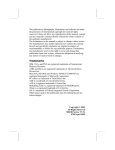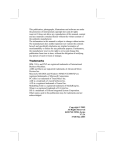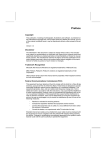Download Mercury KOB 845GL User`s manual
Transcript
Mainboard User’s Manual This publication, photographs, illustrations and software are under the protection of international copyright laws and all rights reserved. It does not allow any reproduction of this manual, content and any materials contained herein without the written consent of the authentic manufacturer. The information in this manual is subject to change without notice. The manufacturer does neither represent nor warrant the contents hereof; and specifically disclaims any implied warranties of merchantability or fitness for any particular purpose. Furthermore, the manufacturer reserves the right to revise and change this publication from time to time, without the obligation of notifying any person of such revision or changes. Trademarks IBM, VGA, and PS/2 are registered trademarks of International Business Machines. Intel, Pentium/II/III, Pentium 4, Celeron and MMX are registered trademarks of Intel Corporation. Microsoft, MS-DOS and Windows 98/ME/NT/2000/XP are registered trademarks of Microsoft Corporation. PC-cillin is a trademark of Trend Micro Inc. AMI is a trademark of American Megatrends Inc. MediaRing Talk is a registered trademark of MediaRing Inc. 3Deep is a registered trademark of E-Color Inc. It has been acknowledged that all mentioned brands or product names are trademarks or registered trademarks of their respective holders. Copyright © 2002 All Rights Reserved KOB 845GL NDSMx V3.1 I845GL/May 2002 P/N: 40-012-D86311 Mainboard User’s Manual Notice: Owing to Microsoft’s certifying schedule is various to every supplier, we might have some drivers not certified yet by Microsoft. Therefore, it might happen under Windows XP that a dialogue box (shown as below) pop out warning you this software has not passed Windows Logo testing to verify its compatibility with Windows XP. Please rest assured that our RD department has already tested and verified these drivers. Click the “Continue Anyway” button and go ahead the installation. II Mainboard User’s Manual Table of Contents Chapter 1: Introduction ...................................................................1 Key Features............................................................................2 Package Contents ....................................................................5 Static Electricity Precautions...................................................6 Pre-Installation Inspection.......................................................6 Chapter 2: Mainboard Installation...................................................7 Mainboard Components ..........................................................8 I/O Ports ..................................................................................9 Installing the Processor..........................................................10 Installing Memory Modules ..................................................11 Jumper Settings .....................................................................13 Install The Mainboard ...........................................................14 Optional Extension Brackets .................................................16 Install Other Devices .............................................................17 Expansion Slots ....................................................................20 Chapter 3: BIOS Setup Utility.......................................................21 Introduction ...........................................................................21 Running the Setup Utility........... …………………………...22 Standard CMOS Setup Page..................................................23 Advanced Setup Page ............................................................24 Power Management Setup Page ............................................27 PCI/Plug and Play Setup Page...............................................29 Load Optimal Settings...........................................................30 Load Best Performance Settings ...........................................30 Features Setup Page...............................................................31 CPU PnP Setup Page .............................................................33 Hardware Monitor Page ........................................................34 Change Password ..................................................................34 Exit ........................................................................................34 Chapter 4: Software & Applications .............................................35 Introduction ...........................................................................35 Installing Support Software...................................................36 Bundled Software Installation ...............................................38 Appendix ...............................................................................39 III Mainboard User’s Manual IV 1: Introduction Chapter 1 Introduction This mainboard has a Socket-478 support for Intel Pentium4 processors with front-side bus (FSB) speeds up to 400 MHz. This mainboard has the Intel 845GL chipset that contains Intel 82845 Memory Controller Hub and Intel 82801 I/O Controller Hub. It supports built-in USB 2.0 providing higher bandwidth. It implements Universal Serial Bus Specification Revision 2.0 and is compliant with UHCI 1.1 and EHCI 0.95. This mainboard supports AC 97 audio codec and provides Ultra DMA 33/66/100 function. This mainboard has two 32-bit PCI, one AGP1 (with Digital Video Output, but without AGP support) and one CNR (Communications and Networking Riser) slot. There is a full set of I/O ports including two PS/2 ports for mouse and keyboard, one serial port, one VGA port, one parallel port, one MIDI/game port and maximum six USB ports(USB 2.0): two back-panel USB ports and you can make four extra USB ports by connecting the extended USB module to the mainboard. This mainboard is an Micro ATX mainboard that uses a 4-layer printed circuit board and measures 244 x 244mm. 1 Mainboard User’s Manual Key Features This mainboard has these key features: Socket-478 Processor ♦ Supports Intel Pentium 4 series CPUs ♦ Supports up to 400 MHz Front-Side Bus Memory Support ♦ Two 168-pin DIMM slots for SDRAM memory modules ♦ Two 184-pin DIMM slots for DDR SDRAM memory modules ♦ Support SDRAM up to 133 MHz/DDR up to 266 MHz memory bus ♦ Maximum installed memory is 2GB Notice: YOU can NOT work SDRAM and DDR simultaneously. AC97 Audio Codec: CMI9738 ♦ Compliant with AC’97 2.2 specification ♦ Full-duplex Codec with independent and variable sampling rate ♦ Earphone Buffer Built-In, SNR up to 90db ♦ 4Ch DAC, support 4-channel speak-out ♦ Advanced power management support Expansion Options The mainboard comes with the following expansion options: ♦ Two 32-bit PCI slots ♦ Supports IDE Ultra DMA bus mastering with transfer rates of 33/66/100 MB/sec ♦ One DVO (without AGP support) slot ♦ One CNR (Communications and Networking Riser) slot 2 1: Introduction Onboard I/O Ports The mainboard has a full set of I/O ports and connectors: ♦ Two PS/2 ports for mouse and keyboard ♦ One serial ports ♦ One parallel port ♦ One VGA port ♦ One MIDI/game port ♦ Six USB ports (two back-panel USB ports, onboard USB headers providing maximum four extra ports: header USB2 and USB3)—all support USB 2.0 ♦ Audio jacks for microphone, line-in and line-out Fast Ethernet LAN ♦ Built-in 10BaseT/100BaseTX Ethernet LAN ♦ Integrated Fast Ethernet MAC and full compliance with IEEE 802.3u 100 Base-T specifications and IEEE 802.3x Full Duplex Flow Control ♦ In compliance with ACPI 1.0 and the Network Device Class Power Management 1.0 ♦ High Performance achieved by 100Mbps clock generator and data recovery circuit for 100Mbps receiver USB 2.0 ♦ Compliant with Universal Serial Bus Specification Revision 2.0 ♦ Compliant with Intel’s Enhanced Host Controller Interface Specification Revision 0.95 ♦ Compliant with Universal Host Controller Interface Specification Revision 1.1 ♦ PCI multi-function device consists of two UHCI Host Controller cores for full-/low-speed signaling and one EHCI Host Controller core for high-speed signaling ♦ Root hub consists 4 downstream facing ports with integrated physical layer transceivers shared by UHCI and EHCI Host Controller ♦ Support PCI-Bus Power Management Interface Specification release 1.1 ♦ Legacy support for all downstream facing ports 3 Mainboard User’s Manual BIOS Firmware This mainboard uses AMI BIOS that enables users to configure many system features including the following: ♦ Power management ♦ Wake-up alarms ♦ CPU parameters and memory timing ♦ CPU and memory timing The firmware can also be used to set parameters for different processor clock speeds. Bundled Software ♦ PC-Cillin 2000 provides automatic virus protection under Windows 98/ME/NT/2000/XP ♦ MediaRing Talk provides PC to PC or PC to Phone internet phone communication ♦ 3Deep delivers the precise imagery and displays accurate color in your monitor ♦ Recovery Genius 21st V5.0 provides the function to recover, reserve and transfer hard disk data. ♦ CD Ghost is the software stimulating a real CD-ROM to perform equivalent function. ♦ Language Genius 21st is the software to provides learning tools of language and singing. ♦ PC DJ is a dual-MP3 player that enables users to actually mix music right on their own personal computers. ♦ Adobe Acrobat Reader V5.0 is the software to help users read .PDF files. Dimensions ♦ ATX form factor of 244 x 244mm 4 1: Introduction Package Contents Attention: This mainboard serial has two models, KOB845GL NDSMx and KOB845GL NDSMx ulr (USB 2.0, LAN Ready). Please contact your local supplier for more information about your purchased model. Each model will support different specification listed as below: Model Specification KOB845GL Support USB connector only NDSMx KOB845GL Onboard RTL8100 LAN chipset (U7), NDSMx ulr support USB 2.0 + RJ-45 LAN connector Your mainboard package contains the following items: The mainboard The User’s Manual One diskette drive ribbon cable One IDE drive ribbon cable Software support CD Optional Accessories You can purchase the following optional accessories for this mainboard. Extended USB module CNR v.90 56K Fax/Modem card 5 Mainboard User’s Manual Static Electricity Precautions Static electricity could damage components on this mainboard. Take the following precautions while unpacking this mainboard and installing it in a system. 1. Don’t take this mainboard and components out of their original static-proof package until you are ready to install them. 2. While installing, please wear a grounded wrist strap if possible. If you don’t have a wrist strap, discharge static electricity by touching the bare metal of the system chassis. 3. Carefully hold this mainboard by its edges. Do not touch those components unless it is absolutely necessary. Put this mainboard on the top of static-protection package with component side facing up while installing. Pre-Installation Inspection 1. Inspect this mainboard whether there are any damages to components and connectors on the board. 2. If you suspect this mainboard has been damaged, do not connect power to the system. Contact your mainboard vendor about those damages. 6 2: Mainboard Installation Chapter 2 Mainboard Installation To install this mainboard in a system, please follow these instructions in this chapter: Identify the mainboard components Install a CPU Install one or more system memory modules Make sure all jumpers and switches are set correctly Install this mainboard in a system chassis (case) Connect any extension brackets or cables to connecting headers on the mainboard Install other devices and make the appropriate connections to the mainboard connecting headers Note: 1. Before installing this mainboard, make sure jumper JP2 is under Normal setting. See this chapter for information about locating JP2 and the setting options. 2. Never connect power to the system during installation; otherwise, it may damage the mainboard. 7 Mainboard User’s Manual Mainboard Components Identify major components on the mainboard via this diagram underneath. Note: Any jumpers on your mainboard that do not appear in this illustration are for testing only. 8 2: Mainboard Installation I/O Ports The illustration below shows a side view of the built-in I/O ports on the mainboard. LAN port PS/2 mouse PS/2 keyboard USB ports Parallel port (LPT1) Serial port VGA port COM 1 VGA1 Game port Microphone Line-in Line-out 1. The upper PS/2 port connects a PS/2 pointing device. 2. The lower PS/2 port connects a PS/2 keyboard. 3. The USB ports connect USB devices. 4. LPT1 connects printers or other parallel communications devices. 5. The COM port connects serial devices such as mice or fax/modems; VGA port connects to graphic display devices. 6. The game port connects a joystick or a MIDI device. 7. Three audio ports connect audio devices. The left side jack is for a stereo line-out signal. The middle jack is for a stereo line-in signal. The right side jack is for a microphone. 8. LAN port connects the network. 9 Mainboard User’s Manual Installing the Processor This mainboard has a Socket 478 processor socket. When choosing a processor, consider the performance requirements of the system. Performance is based on the processor design, the clock speed and system bus frequency of the processor, and the quantity of internal cache memory and external cache memory. CPU Installation Procedure Follow these instructions to install the CPU: 1. Unhook the CPU socket’s locking lever by pulling it away from socket and raising it to the upright position. 2. Match the pin 1 corner of CPU socket to the one of processor, and insert the processor into the socket. Do not use force. 3. Push the locking lever down and hook it under the latch on the edge of socket. 4. Apply thermal grease to the top of the CPU. 5. Lower the CPU fan/heatsink unit onto the CPU and CPU socket, and then use the retention module clamps to snap the fan/heatsink into place. 6. Plug the CPU fan power cable into the CPU cooling fan power supply connector on the mainboard. 10 2: Mainboard Installation Installing Memory Modules This mainboard accommodates 168-pin 3.3V/184-pin 2.5V unbuffered SDRAM memory modules. The memory chips must be standard or registered SDRAM (Synchronous Dynamic Random Access Memory). The CPU supports 100MHz system bus. The SDRAM DIMMs and DDRs can synchronously work with 100 MHz or operates over a 133 MHz memory bus. You must install at least one memory module in order to use the mainboard, either SDRAM or DDR SDRAM, but you cannot use them simultaneously. Note: Please be noted you must set up the correct jumper settings (JT1~JT11) as described in page 13 of this chapter. SDRAM provides 800 MB/s or 1 GB/s data transfer rate corresponding with the bus 100 MHz or 133 MHz. It doubles the rate to 1.6 GB/s and 2.1 GB/s by transferring data on both the rising and falling edges of the clock. DDR SDRAM uses additional power and ground lines and requires 184-pin 2.5V unbuffered DIMM module rather than the 168-pin 3.3V unbuffered DIMMs used by SDRAM. SDR1 DDR1 SDR2 DDR2 11 Mainboard User’s Manual Installation Procedure The mainboard accommodates two memory modules. You must install at least one module in any of the three slots. Each module can be installed with up to 2 GB system memory. Refer to the following to install the memory modules. 1. Push the latches on each side of the DIMM slot down. 2. Align the memory module with the slot. The DIMM slots are keyed with notches and the DIMMs are keyed with cutouts so that they can only be installed correctly. 3. Check that the cutouts on the DIMM module edge connector match the notches in the DIMM slot. 4. Install the DIMM module into the slot and press it firmly down until it seats correctly. The slot latches are levered upwards and latch on to the edges of the DIMM. 5. Install any remaining DIMM modules. 12 2: Mainboard Installation Jumper Settings JP2 JT1 JT2 JT7 JT3 JT8 JT4 JT5 JT6 JT9 JT10 JT11 JP2: Clear CMOS Jumper Use this jumper to clear the contents of the CMOS memory. You may need to clear the CMOS memory if the settings in the Setup Utility are incorrect and prevent your mainboard from operating. To clear the CMOS memory, disconnect all the power cables from the mainboard and then move the jumper cap into the CLEAR setting for a few seconds. Function Normal Clear CMOS Jumper Setting Short Pins 1-2 Short Pins 2-3 JT1~JT11: DDR/SDR DRAM Type Selector This jumper enables to select DDR or SDR DRAM type. Function DDR SDRAM Jumper Setting Short all JT1~JT11 pins Open all JT1~JT11 pins 13 Mainboard User’s Manual Install the Mainboard Install the mainboard in a system chassis (case). The board is an ATX size mainboard with a twin-tier of I/O ports. You can install this mainboard in an ATX case. Ensure that your case has an I/O cover plate that matches the ports on this mainboard. Install the mainboard in a case. Follow the instructions provided by the case manufacturer using the hardware and internal mounting points on the chassis. 1 PW1 AUDIO1 1 PANEL1 CHS FAN 1 1 SPKR1 PLED1 Connect the power connector from the power supply to the PW1 connector on the mainboard. If there is a cooling fan installed in the system chassis, connect the cable from the cooling fan to the CHS FAN fan power connector on the mainboard. Connect the cable from the PC speaker to the SPKR1 header on the mainboard. Pin 1 3 14 Signal SPKR GND Pin 2 4 Signal NC +5V 2: Mainboard Installation Connect the case switches and indicator LEDs to the PANEL1 header. Here is a list of the PANEL1 header’s pin assignments. Pin 1 3 5 7 9 Signal HDD_LED_P HDD_LED_N RESET_SW_N RESET_SW_P KEY Pin 2 4 6 8 10 Signal ACPI-LED ACPI-LED POWER-BT POWER-BT KEY If there are a headphone jack or/and a microphone jack on the front panel, connect the cables to the AUDIO1 header on the mainboard. Here is a list of the AUDIO header’s pin assignments. Pin 1 3 5 7 9 Signal AUD_MIC AUD_MIC_BIAS AUD_FPOUT_R HP_ON AUD_FPOUT_L Pin 2 4 6 8 10 Signal AUD_GND AUD_VCC GND KEY GND If there is another power-on indicator LED installed in the system chassis, connect the LED to the PLED1 header. Pin 1 2 3 Signal GROUND NC POWER 15 Mainboard User’s Manual Optional Extension Brackets For this mainboard, you can also obtain a USB module extension bracket for more USB ports. Install them by following the steps below. Note: All the ribbon cables used on the extension brackets have a red stripe on the Pin-1 side of the cable. Extended USB Module This module bracket has four USB 2.0 ports for more USB devices (USB 2.0 port USB2, USB3). 1 USB2 1 USB3 Pin 1 3 5 7 9 Signal VERG_FP_USBPWR0 USB_FP_P0USB_FP_P0+ GROUND KEY Pin 2 4 6 8 10 Signal VERG_FP_USBPWR0 USB_FP_P1USB_FP_P1+ GROUND NC 1. Locate the USB2/USB3 header on the mainboard. 2. Plug the bracket cable onto the USB2/USB3 header. 3. In the system chassis, remove a slot cover from one of the expansion slots and install the extension bracket in the opening. Secure the extension bracket to the chassis with a screw. 16 2: Mainboard Installation Install Other Devices Install and connect any other devices in the system following the steps below. FLOPPY IDE1 IDE2 Floppy Disk Drive The mainboard ships with a floppy disk drive cable that can support one or two drives. Drives can be 3.5” or 5.25” wide, with capacities of 360K, 720K, 1.2MB, 1.44MB, or 2.88MB. Install your drives and connect power from the system power supply. Use the cable provided to connect the drives to the floppy disk drive connector FLOPPY. IDE Devices IDE devices include hard disk drives, high-density diskette drives, and CD-ROM or DVD-ROM drives, among others. The mainboard ships with an IDE cable that can support one or two IDE devices. If you connect two devices to a single cable, you must configure one of the drives as Master and one of the drives as Slave. The documentation of the IDE device will tell you how to configure the device as a Master or Slave device. The Master device connects to the end of the cable. 17 Mainboard User’s Manual Install the device(s) and connect power from the system power supply. Use the cable provided to connect the device(s) to the Primary IDE channel connector IDE1 on the mainboard. If you want to install more IDE devices, you can purchase a second IDE cable and connect one or two devices to the Secondary IDE channel connector IDE2 on the mainboard. If you have two devices on the cable, one must be Master and one must be Slave. Internal Sound Connections If you have installed a CD-ROM drive or DVD-ROM drive, you can connect the drive audio cable to the onboard sound system. SIR1 1 1 CD1 CD2 WOL1 On the mainboard, locate the two 4-pin connectors CD1 and CD2. There are two kinds of connector because different brands of CDROM drive have different kinds of audio cable connectors. Connect the cable to the appropriate connector. CD1 Pin 1 2 3 4 Signal CD IN L GND GND CD IN R CD2 Pin 1 2 3 4 18 Signal GND CD IN R GND CD IN L 2: Mainboard Installation WOL1: Wake On LAN If you have installed a LAN card, use the cable provided with the card to plug into the mainboard WOL1 connector. This enables the Wake On LAN (WOL1) feature. When your system is in a powersaving mode, any LAN signal automatically resumes the system. You must enable this item using the Power Management page of the Setup Utility. Pin 1 2 3 Signal 5VSB GND -RING Infrared Port You can connect an infrared port to the mainboard. You can purchase this option from third-party vendors. 1. Locate the infrared port SIR1 header on the mainboard. 2. If you are adding an infrared port, connect the ribbon cable from the port to the IR header and then secure the port to an appropriate place in your system chassis. Pin 1 3 5 Signal NC +5V IRTX Pin 2 4 6 Signal KEY GND IRRX 19 Mainboard User’s Manual Expansion Slots This mainboard has one AGP, one CNR and two 32-bit PCI slots. AGP1 CNR1 PCI2 PCI1 Follow the steps below to install a AGP/CNR/PCI expansion card. 1. Locate the AGP, CNR or PCI slots on the mainboard. 2. Remove the slot cover for this slot from the system chassis. 3. Insert the expansion card edge connector into the slot and press it firmly down into it so that it is fully inserted. 4. Secure the expansion card bracket to the system chassis using the screw that held the slot cover in place. PCI Slots You can install 32-bit PCI interface expansion cards in PCI slots. Slot1 only supports PC5 Slave mode. It is recommended you give first priority to PCI 1~4 slots while inserting cards. AGP1 This slot supports the DVO (Digital Video Output) function (without AGP support) for a TV or video monitor displaying. CNR Slot This slot is used to insert CNR (Communications and Networking Riser) cards including LAN, Modem, and Audio functions. 20 3: BIOS Setup Utility Chapter 3 BIOS Setup Utility Introduction The BIOS Setup Utility records settings and information of your computer, such as date and time, the type of hardware installed, and various configuration settings. Your computer applies those information to initialize all the components when booting up and basic functions of coordination between system components. If the Setup Utility configuration is incorrect, it may cause the system to malfunction. It can even stop your computer booting properly. If it happens, you can use the clear CMOS jumper to clear the CMOS memory which has stored the configuration information; or you can hold down the Page Up key while rebooting your computer. Holding down the Page Up key also clears the setup information. You can run the setup utility and manually change the configuration. You might need to do this to configure some hardware installed in or connected to the mainboard, such as the CPU, system memory, disk drives, etc. 21 Mainboard User’s Manual Running the Setup Utility Every time you start your computer, a message appears on the screen before the operating system loading that prompts you to “Hit <DEL>if you want to run SETUP”. Whenever you see this message, press the Delete key, and the Main menu page of the Setup Utility appears on your monitor. AMIBIOS SIMPLE SETUP UTILITY – VERSION 1.21.10 (C) 2000 American Megatrends, Inc. All Rights Reserved Standard CMOS Setup Advanced Setup Power Management Setup PCI / Plug and Play Setup Load Optimal Settings Load Best Performance Settings Features Setup CPU PnP Setup Hardware Monitor Change Password Exit Esc : Quit ↑ ↓ ← →: Select Item (Shift)F2 : Change Color F5 : Old Values F6 : Optimal values F7 : Best performance values F10 : Save&Exit Standards COMOS setup for changing time, date, hard disk type, etc. You can use cursor arrow keys to highlight anyone of options on the main menu page. Press Enter to select the highlighted option. Press the Escape key to leave the setup utility. Hold down the Shift key and press F2 to cycle through the Setup Utility’s optional color schemes. Some options on the main menu page lead to tables of items with installed values that you can use cursor arrow keys to highlight one item, and press PgUp and PgDn keys to cycle through alternative values of that item. The other options on the main menu page lead to dialog boxes that require your answer Yes or No by hitting the Y or N keys. If you have already changed the setup utility, press F10 to save those changes and exit the utility. Press F5 to reset the changes to the original values. Press F6 to install the setup utility with a set of default values. Press F7 to install the setup utility with a set of high-performance values. 22 3: BIOS Setup Utility Standard CMOS Setup Page This page displays a table of items defining basic information about your system. AMIBIOS SETUP – STANDARD CMOS SETUP (C) 2000 American Megatrends, Inc. All Rights Reserved Date (mm/dd/yy) : Mon May 20, 2002 Time (hh/mm/ss) : 18:00:45 LBA Blk PIO Type Size Cyln Head WPcom Sec Mode Mode Mode Pri Master : Auto Pri Slave : Auto Sec Master : Auto Sec Slave : Auto Floppy Drive A : 1.44 MB 3 1/2 Floppy Drive B : Not Installed Month : Jan – Dec Day : 01 – 31 Year : 1901 – 2099 Date & Time IDE Pri Master Pri Slave Sec Master Sec Slave Floppy Drive A Floppy Drive B 32Bit Mode On On On On ESC : Exit ↑↓ : Select Item PU/PD/+/- : Modify (Shift)F2 : Color F3 : Detect All HDD These items set up system date and time. These items configure devices connected to the Primary and Secondary IDE channels. To configure an IDE hard disk drive, choose Auto. If the Auto setting fails to find a hard disk drive, set it to User, and then fill in the hard disk characteristics (Size, Cyls, etc.) manually. If you have a CD-ROM drive, select the setting CDROM. If you have an ATAPI device with removable media (e.g. a ZIP drive or an LS-120), select Floptical. These items set up size and capacity of the floppy diskette drive(s) installed in the system. 23 Mainboard User’s Manual Advanced Setup Page This page sets up more advanced information about your system. Handle this page with caution. Any changes can affect the operation of your computer. AMIBIOS SETUP – ADVANCED SETUP (C) 2000 American Megatrends, Inc. All Rights Reserved Quick Boot 1st Boot Device 2nd Boot Device 3rd Boot Device Try Other Boot Devices S.M.A.R.T. for Hard Disks Floppy Drive Swap Floppy Drive Seek PS/2 Mouse Support Password Check L2 Cache System BIOS Cacheable SDRAM Frequency SDRAM Timing by SPD SDRAM CAS# Latency SDRAM RAS# Precharge SDRAM RAS# to CAS# Delay SDRAM Precharge Delay Spread Spectrum Auto Detect DIMM/PCI Clk Delay For Hard Drive (Sec.) Quick Boot 1st Boot Device 2nd Boot Device 3rd Boot Device Try Other Boot Device 24 Enabled IDE-0 Floppy CD/DVD Yes Disabled Disabled Disabled Enabled Setup Enabled Enabled 133MHz Enables 3 Clocks 3 Clocks 3 Clocks 7 Clocks Disabled Enabled 2 ESC F1 F5 F6 F7 : Quit ↑↓←→ : Select Item : Help PU/PD/+/- : Modify : Old Values (Shift)F2 : Color : Load BIOS Defaults : Load Setup Defaults If you enable this item, the system starts up more quickly be elimination some of the power on test routines. Use these items to determine the device order the computer uses to look for an operating system to load at start-up time. If you enable this item, the system will also search for other boot devices if it fails to find an operating system from the first two locations. 3: BIOS Setup Utility S.M.A.R.T. for Hard Disks Floppy Drive Swap Floppy Drive Seek PS/2 Mouse Support Password Check L2 Cache System BIOS Cacheable SDRAM Frequency SDRAM Timing By SPD SDRAM CAS# Latency Enable this item if any IDE hard disks support the S.M.A.R.T. (SelfMonitoring, Analysis and Reporting Technology) feature. If you have two diskette drives installed and you enable this item, drive A becomes drive B and drive B becomes drive A. If you enable this item, your system will check all floppy disk drives at start up. Disable this item unless you are using an old 360KB drive. Enable this item if you plan to use a PS/2 mouse. If you have entered a password for the system, use this item to determine, if the password is required to enter the Setup Utility (Setup) or required both at startup and to enter the Setup Utility (Always). Leave these items enabled since all the processors that can be installed on this board have internal L2 cache memory. If you enable this item, a segment of the system BIOS will be copied to main memory for faster execution. This item determines frequency of SDRAM memory. This item allows you to enable or disable the SDRAM timing defined by the Serial Presence Detect electrical. This item determines the operation of SDRAM memory CAS (column address strobe). It is recommended that you leave this item at the default value. The 2T setting requires faster memory that specifically supports this mode. 25 Mainboard User’s Manual SDRAM RAS# Precharge SDRAM RAS# to CAS# Delay SDRAM RAS# Precharge Delay Spread Spectrum Auto detect DIMM/PCI Clock Delay For Hard Drive (Sec.) 26 Select the number of CPU clocks allocated for the Row Address Strobe (RAS#) signal to accumulate its charge before the SDRAM is refreshed. If insufficient time is allowed, refresh may be incomplete and data lost. This field lets you insert a timing delay between the CAS and RAS strobe signals, used when SDRAM is written to, read from, or refreshed. Disabled gives faster performance; and Enabled gives more stable performance. The precharge time is the number of cycles it takes for SDRAM to accumulate its charge before refresh. If you enable spread spectrum, it can significantly reduce the EMI (ElectroMagnetic Interference) generated by the system. When this item is enabled, BIOS will disable the clock signal of free DIMM/PCI slots. If you enable this item, your had drive will be delayed for a preset period of time. We recommend you leave this item at the default value. 3: BIOS Setup Utility Power Management Setup Page This page sets some parameters for system power management operation. AMIBIOS SETUP – POWER MANAGEMENT SETUP (C) 2000 American Megatrends, Inc. All Rights Reserved ACPI Aware O/S Power Management/APM Suspend Time Out (Minute) Hard Disk Time Out (Minute) Resume On RTC Alarm RTC Alarm Date RTC Alarm Hour RTC Alarm Minute RTC Alarm Second LAN/Ring Power On Keyboard Power On Function Specific Key for PowerOn ACPI Aware O/S Power Management Suspend Time Out (Minute) Hard Disk Time Out (Minute) Yes Enabled Disabled Disabled Disabled 15 12 30 30 Disabled Disabled N/A ESC F1 F5 F6 F7 : : : : : Quit ↑↓←→ : Select Item Help PU/PD/+/- : Modify Old Values (Shift)F2 : Color Load BIOS Defaults Load Setup Defaults This item supports ACPI (Advanced Configuration and Power management Interface). Use this item to enable or disable the ACPI feature. Use this item to enable or disable a power management scheme. If you enable power management, you can use the items below to set the power management operation. Both APM and ACPI are supported. This sets the timeout for Suspend mode in minutes. If the time selected passes without any system activity, the computer will enter power-saving Suspend mode. This item sets up the timeout to power down the hard disk drive, if there is no hard disk activity after passing the preset period of time. 27 Mainboard User’s Manual Resume On RTC Alarm / Date / Hour / Minute / Second LAN/Ring Power On Keyboard Power On Function Specific Key for PowerOn 28 The system can be turned off with a software command. If you enable this item, the system can automatically resume at a fixed time based on the system’s RTC (realtime clock). Use the items below this one to set the date and time of the wake-up alarm. You must use an ATX power supply in order to use this feature. Your system can enter the software power down. If you enable this item, the system can automatically resume if there is traffic on the network adapter. If you enable this item, you can turn the system on and off by pressing hot keys on the keyboard. You must enable the Keyboard Power On jumper and use an ATX power supply in order to use this feature. When the Power On function is set to Password, use this item to set the password. 3: BIOS Setup Utility PCI / Plug and Play Setup Page This page sets up some parameters for devices installed on the PCI bus and those utilizing the system plug and play capability. AMIBIOS SETUP – PCI / PLUG AND PLAY SETUP (C) 2000 American Megatrends, Inc. All Rights Reserved Primary Graphics Adapter OnChip VGA Mode Select Allocate IRQ to PCI VGA Reserved 1MB Yes ESC F1 F5 F6 F7 Primary Graphics Adapter OnChip VGA Mode Select Allocate IRQ to PCI VGA : : : : : Quit ↑↓←→ : Select Item Help PU/PD/+/- : Modify Old Values (Shift)F2 : Color Load BIOS Defaults Load Setup Defaults This item indicates if the primary graphics adapter uses the PCI or the AGP bus. The default AGP setting still lets the onboard display work and allows the use of a second display card installed in an AGP slot. This item provides the VGA mode with four options of 1MB, 8MB, Disabled or 512KB. We recommend you leave this item at the default value. If this item is enabled, an IRQ will be assigned to the PCI VGA graphics system. You set this value to No to free up an IRQ. 29 Mainboard User’s Manual Load Optimal Settings If you select this item and press Enter a dialog box appears. If you press Y, and then Enter, the Setup Utility loads a set of fail-safe default values. These default values are not very demanding and they should allow your system to function with most kinds of hardware and memory chips. Note : It is highly recommend that users enter this option to load optimal values for accessing the best performance. Load Best Performance Settings If you select this item and press Enter a dialog box appears. If you press Y, and then Enter, the Setup Utility loads a set of bestperformance default values. These default values are quite demanding and your system might not function properly if you are using slower memory chips or other low-performance components. 30 3: BIOS Setup Utility Features Setup Page This page sets up some parameters for peripheral devices connected to the system. AMIBIOS SETUP – FEATURES SETUP (C) 2000 American Megatrends, Inc. All Rights Reserved OnBoard FDC OnBoard Serial PortA OnBoard IR Port OnBoard Parallel Port Parallel Port Mode EPP Version Parallel Port IRQ Parallel Port DMA Channel OnBoard MIDI Port MIDI IRQ Select OnBoard Game Port OnBoard IDE Audio Device Modem Device USB 2.0 Support Onboard USB Function Support USB Function For DOS ThumbDrive Support For DOS OnBoard FDC OnBoard Serial PortA OnBoard IR Port Enabled 3F8/COM1 Disabled Auto ECP N/A Auto Auto 300 5 200 Both Auto Auto Enabled 6 USB Ports Disabled Disabled ESC Item F1 F5 F6 F7 : Quit : : : : ↑↓←→ : Select Help PU/PD/+/- : Modify Old Values (Shift)F2 : Color Load BIOS Defaults Load Setup Defaults This item enables or disables the onboard floppy disk drive interface. These items enable or disable the onboard COM1 serial port, and to assign a port address. This item enables or disables the Infrared port, and assigns a port address. If you select a specific address, the resources are assigned to the IR port, and you can use these items below to determine the operation of the IR port. 31 Mainboard User’s Manual Onboard Parallel Port Parallel Port Mode Parallel Port IRQ Parallel Port DMA Channel OnBoard MIDI Port MIDI IRQ Select OnBoard Game Port OnBoard IDE Audio Device Modem Device USB 2.0 Support Onboard USB Function Support USB Function For DOS ThumbDrive Support For DOS 32 This item enables or disables the onboard LPT1 parallel port, and to assign a port address. The Auto setting will detect and available address. This item sets the parallel port mode. You can select SPP (Standard Parallel Port), ECP (Extended Capabilities Port), EPP (Enhanced Parallel Port), or ECP + EPP. This item assigns IRQ to the parallel port. This item assigns a DMA channel to the parallel port. This item enables or disables the onboard MIDI port, and to assign a port address. This item assigns IRQ 5 to the parallel port. This item enables or disables the I/O address for the game port. This item enables or disables the onboard IDE channel. This item enables or disables the AC’97 audio chip. This item enables or disables the MC’97 modem chip. This item enables or disables the USB 2.0 feature. Enable this item if you plan to use the USB ports on this mainboard. Enable this item if you plan to use the USB ports on this mainboard in a DOS environment. Enable this item to make a small portion of memory storage device for the USB ports. 3: BIOS Setup Utility CPU PnP Setup Page This page helps you manually configure the CPU of this mainboard. The system will automatically detect the type of installed CPU and make the appropriate adjustments to these items on this page. AMIBIOS SETUP – CPU PnP SETUP ©2000 American Megatrends, Inc. All Rights Reserved CPU Type CPU Core Voltage CPU Ratio Selection CPU Speed INTEL P4 1.728 V 8.0x 133 MHz ESC F1 F5 F6 F7 CPU Type/ Core Voltage/ Ratio /Speed : : : : : Quit ↑↓←→ : Select Item Help PU/PD/+/- : Modify Old Values (Shift)F2 : Color Load Optimal values Load Best performance values These items show the type, core voltage, ratio and speed of CPU installed in your system. 33 Mainboard User’s Manual Hardware Monitor Page This page sets up some parameters for the hardware monitoring function of this mainboard. AMIBIOS SETUP – HARDWARE MONITOR (C) 2000 American Megatrends, Inc. All Rights Reserved *** System Hardware *** Vcore Vcc 3.3V Vcc +12V -12V -Vcc SB5V VBAT SYSTEM Fan Speed CPU Fan Speed SYSTEM Temperature CPU Temperature CPU / System Temperature FANs & Voltage Measurements 1.728 V 3.312 V 5.030 V 12.045V -12.071V -5.026V 4.800 V 3.248 V 0 RPM 3629 RPM 28°C/82°F 59°C/138°F ESC F1 F5 F6 F7 : : : : : Quit ↑↓←→ : Select Item Help PU/PD/+/- : Modify Old Values (Shift)F2 : Color Load BIOS Defaults Load Setup Defaults These items display CPU and system temperature measurement. These items indicate cooling fan speeds in RPM and the various system voltage measurements. Change Password If you highlight this item and press Enter, a dialog box appears that you can enter a Supervisor password. You can enter no more than six letters or numbers. Press Enter after you have typed in the password. There will be the second dialog box asking you to retype the password for confirmation. Press Enter after you have retyped it correctly. Then, the password is required for the access to the Setup Utility or for it at start-up, depending on the setting of the Password Check item in Advanced Setup. Exit Highlight this item and press Enter to save the changes that you have made in the Setup Utility configuration and exit the program. When the Save and Exit dialog box appears, press Y to save and exit, or press N to exit without saving. 34 4: Software & Applications Chapter 4 Software & Applications Introduction This chapter describes the contents of the support CD-ROM that comes with the mainboard package. The support CD-ROM contains all useful software, necessary drivers and utility programs to properly run our products. More program information is available in a README file, located in the same directory as the software. To run the support CD, simply insert the CD into your CD-ROM drive. An Auto Setup screen automatically pops out, and then you can go on the auto-installing or manual installation depending on your operating system. If your operating system is Windows 98/ME/2000/XP, it will automatically install all the drivers and utilities for your mainboard; if Windows NT or manual installation, please follow the instructions described as the Installing under Windows NT or Manual Installation section. 35 Mainboard User’s Manual Installing Support Software 1.Insert the support CD-ROM disc in the CD-ROM drive. 2.When you insert the CD-ROM disc in the system CD-ROM drive, the CD automatically displays an Auto Setup screen. 3.The screen displays three buttons of Setup, Browse CD and Exit on the right side, and three others Setup, Application and ReadMe at the bottom. Please see the following illustration. The Setup button runs the software auto-installing program as explained in next section. The Browse CD button is a standard Windows command that you can check the contents of the disc with the Windows 98 file browsing interface. The Exit button closes the Auto Setup window. To run the program again, reinsert the CD-ROM disc in the drive; or click the CD-ROM driver from the Windows Explorer, and click the Setup icon. The Application button brings up a software menu. It shows the bundled software that this mainboard supports. The ReadMe brings you to the Install Path where you can find out path names of software driver. 36 4: Software & Applications Auto-Installing under Windows 98/ME/2000/XP If you are under Windows 98/ME/2000/XP, please click the Setup button to run the software auto-installing program while the Auto Setup screen pops out after inserting the support CD-ROM: 1. The installation program loads and displays the following screen. Click the Next button. 2. Select the items that you want to setup by clicking on it (the default options are recommended). Click the Next button to proceed. 3. The support software will automatically install. Once any of the installation procedures start, software is automatically installed in sequence. You need to follow the onscreen instructions, confirm commands and allow the computer to restart as few times as needed to complete installing whatever software you selected. When the process is finished, all the support software will be installed and start working. 37 Mainboard User’s Manual Installing under Windows NT or Manual Installation If you are under Windows NT, the auto-installing program doesn’t work out; or you have to do the manual installation, please follow this procedure while the Auto Setup screen pops out after inserting the support CD-ROM: 1. Click the ReadMe to bring up a screen, and then click the Install Path at the bottom of the screen. 2. Find out your mainboard model name and click on it to obtain its correct driver directory. 3. Install each software in accordance with the corresponding driver path. Bundled Software Installation All bundled software available on the CD-ROM is for users’ convenience. You can install bundled software as follows: 1. Click the Application button while the Auto Setup screen pops out after inserting the support CD-ROM. 2. A software menu appears. Click the software you want to install. 3. Follow onscreen instructions to install the software program step by step until finished. 38 Appendix Appendix Intel USB 2.0 Driver Limitations & Manual Installation 1.USB2.0 Driver only supports the Operating System WinXP/Win2K, and WinME & Win98SE driver only supports USB 1.1 function. 2.You must follow these steps to execute manual installation of WinXP driver; otherwise, you can’t succeed this driver installation. 2-1.Clean Install Windows XP with PS2 Keyboard/Mouse. 2-2.Install INF Update 4.00.1009 PV. •Install IAA 2.1 PV (2124). •Install GFX 11.0 PC 1.01 (3051). •Install LAN 6.1 PV. •Install AC97 Beta. 2-3.Install USB 2.0 for XP 3616. 2-4.Use Tools/Folder Options…/View. To change below item: •Enable “Display the full path in the title bar”. •Enable “Show Hidden files and folders”. •Disable “Hide extensions of known files types”. •Disable “Hide protected operating system files (Recommended)”. 2-5.Check USB driver version from C:\Windows\System32\Drivers directory (My Computer, Local Disk C:, Show the content of this drive, Windows directory, Show the content of this drive, System32 directory, Show the content of this drive, Drivers directory, Show the content of this drive, View, Details.) USBEHCI.SYS – 3/20/2002. USBPORT.SYS – 8/17/2001. USBHUB.SYS – 8/17/2001. 2-6.So, new 3616 driver does not install completed. 39 Mainboard User’s Manual 2-7.Manual installation: 2-7-1 Disable Windows File Protection (WFP) •From Start button/run/Regedit. • Set HKEY_LOCAL_MACHINE\Software\Microsoft\Windows NT\CurrentVersion\Winlogon\SFCDisable = 1 2-7-2 Copy all USB files from CD to HDD. •Copy all test drivers to %windir%\driver cache\i386. •Copy all test drivers to %windir%\system32\dllcache You need to copy file to this directory first. Otherwise, Windows XP will replace file from this directory to system32\drivers. •Copy all test drivers to %windir%\system32\drivers. 2-7-3. Check USB driver version again. USBEHCI.SYS – 3/20/2002. USBPORT.SYS – 3/20/2001. USBHUB.SYS – 3/20/2001. 2-7-4. Enable Windows File Protection (WFP) •Start button/run/Regedit. •Set HKEY_LOCAL_MACHINE\Software\Microsoft\Windows NT\CurrentVersion\Winlogon\SFCDisable = 0 3. Installing USB2.0 driver under WinME operating system, there is a green question mark popping out. Please rest assured it is normal. 4. It doesn’t support the feature of USB Function For Dos Enable in the BIOS Setup Utility under the Window operating system. 5. The USB Keyboard Chicony KU-8933 doesn’t work out. 40












































